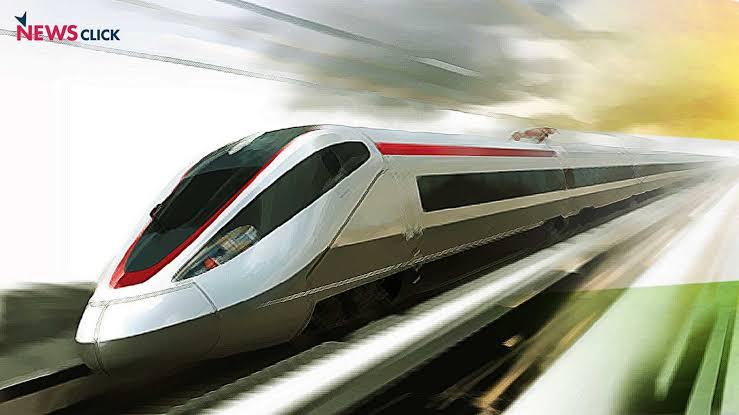Bullet Train Likely to Miss Target as Land Acquisitions Create Hurdle

Facing hurdles in land acquisition, India's first high speed train corridor between Mumbai and Ahmedabad is likely to miss the August 2022 target despite the fact that all other related work are going on in full speed.
Though the original plan was to make the 508 km-long, first high-speed route between Mumbai and Ahmedabad in the country operational by the end of 2023, the target was preponed by the Modi government to mark India completing 75 years of independence by partially commissioning the bullet train service on August 15, 2022. As such, the plan was to make the 50 km section from Surat to Billimora in Gujarat operational on Independence Day.
However, with only 50% of the land being acquired till date, it seems to be a tough job for the National High Speed Rail Corporation Limited (NHSRCL), the implementing agency of the project. Even the original target of making it operational by 2023 seems to be far now.
Land acquisition was delayed due to the 2019 Assembly elections in Maharashtra, while in Gujarat, the High Court in September had dismissed over 120 petitions filed by farmers challenging the process of their land acquisition for the project. The court was satisfied with the social and environmental impact assessment carried out by a private agency engaged by the NHSRCL, as per guidelines of the Japan International Cooperation Agency (JICA), which is funding the mega project.
Also read: This Time, in Shadow of a Bullet Train
The project is facing resistance from farmers who are not ready to part with their land. Opposition to the project has been most strident in Palghar, a district near Mumbai. However, the NHSRCL has maintained that the acquisition is based on consent, and is fair and transparent. It is hopeful that land acquisition will be completed as as per its claims, people are coming forward and are participating in the land acquisition process with the help of the district administration.
The entire high speed rail corridor will require 1,434 hectares of land with 353 hectares in Maharashtra and the rest in Gujarat. This is divided into 7,000 plots, in 195 villages in Gujarat and in 104 villages in Maharashtra. The project covers three districts in Maharashtra and eight in Guajarat, besides a small area in Dadra and Nagar Haveli.
In August 2019, Minister of State for Railways, Suresh Angadi, informed Parliament that 297 villages were located along the proposed route in Gujarat and 97% of land owners in the state had consented to land acquisition but the government was still facing challenges in acquiring land in certain pockets of Maharashtra.
It is estimated that of the total Rs 1,10,000 crore that will be spent on the project, Rs 88,000 crore will be given to India as loan. These loans will be available at 0.1% interest and India can repay them in 50 years with a moratorium on repayments up to 15 years.
The bullet train project was launched at a ceremony in Gandhinagar in Ahmedabad in September 2017 attended by the Japanese Prime Minister Shinzo Abe, along with Indian Prime Minister Narendra Modi.
According to an official working on the project, the work is going on full speed and till now, out of the 508 km route, tender has been floated for 348 km at an estimated cost of over Rs 35,000 crore.
Also read: Farmers Protest as Maharashtra Govt. Set to Forcefully Acquire Land for Bullet Train
NHSRCL will procure 24 E5 Series Shinkansen train sets to operate on the corridor, of which six are to be assembled in India. The trains are being customised to operate in Indian conditions. The Shinkansen or bullet trains are EMU train sets and different from loco-hauled trains and metro trains in India. The tender for procuring 24 trainsets has already been floated and it would open by the end of December. The estimated cost of the 24 train sets with 10 coaches each is about Rs 8,000 crore.
The high-speed rail will have 12 stations between Mumbai and Ahmedabad. The proposed stations are Bandra Kurla Complex, Thane, Virar, Boisar, Vapi, Bilimora, Surat, Bharuch, Vadodara, Anand, Ahmedabad and Sabarmati. The bullet train, with the capacity to accommodate 750 people, is expected to reduce the travel time between the two major metropolises to less than three hours from the current seven hours.
According to the feasibility report, if the train stops at these 12 stations, it will cover the distance in two hours and 58 minutes at a speed of 320 kmph. However, if the train stops at only four stations, the distance can be covered in two hours and seven minutes.
Of the 508 km route, 468 km of the track will be elevated, 27 km of the route will have a tunnel and the remaining 13 km will be on the ground. The 27 km of tunnel will pass through seven kilometres under the sea near Thane, making it India’s first underwater rail route. NHSRCL floated a third tender this year for 90 km of viaduct including one station at Anand. With this, NHSRCL has invited bids for the construction of about 69% (348 kms) of the total 508 kms, including 21 kms of underground tunnel, 5 elevated stations and one depot at Surat.
Earlier this year, bids were invited for the 237.10 km long viaduct between Zaroli village at Maharashtra-Gujarat Border and Vadodara in Gujarat. Another tender was for the underground tunnel of about 21 kms including 7 kms of undersea tunnel in Maharashtra.
According to the feasibility report, fares on the high-speed train are expected to be 1.5 times higher than the current first class AC fare on the Mumbai-Ahmedabad route. Maximum fare was expected to be Rs 3,000 and the minimum fare would be Rs 250.
Also watch: Along the Tracks of Bullet Train- A Ground Report
Besides the feasibility and technical reports that have been prepared, soil and rocks below the 70-metre deep sea are being tested as part of the geo-technical and geo-physical investigation undertaken for the project. There is also a plan to employ 28 drivers for bullet train operations in the current financial year. The corridor uses three depots at Sabarmati and Surat in Gujarat and Thane in Maharashtra. These trains will be equipped with facilities like foldable beds for baby feedingand patients and there will be baggage racks.
Get the latest reports & analysis with people's perspective on Protests, movements & deep analytical videos, discussions of the current affairs in your Telegram app. Subscribe to NewsClick's Telegram channel & get Real-Time updates on stories, as they get published on our website.























